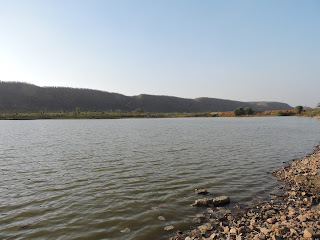Mandalvas watershed development - Mandalvas bandh
Appropriate site selection, site specific structure and participation of villagers in the execution gives you great output.
One more experience, this time from Alwar district in Rajasthan. We were visiting different sites where Tarun Bharat Sangh has executed watershed development projects for years.
 Mandalvas is a village situated at base of a small hill range, on a plateau. The hillas almost encircle the village. There are several small 'Johads" (earthen bunds forming water reservoirs) in & around the village. But, the one I am writing about is the largest bund in the area.
Mandalvas is a village situated at base of a small hill range, on a plateau. The hillas almost encircle the village. There are several small 'Johads" (earthen bunds forming water reservoirs) in & around the village. But, the one I am writing about is the largest bund in the area.Villagers were facing water shortage & very few farmers were able to take two crops in the area. And due to lack of sufficient water, the yield was also not desirable.
With the expertise of Dr Rajendra Singh, active participation of "Tarun Bharat Sangh" and villagers, a large earthen bund was built in the area after proper site selection. It took about 5-6 years for villagers to build the reservoir step by step and the work is still going on. But, we can see the results now after 6 years.
The reservoir has now capacity of more than 30 crore liters. It has spread over a kilometer behind the bund, with maximum depth of 15 meters.
 Earlier very few farmers were able to take crops. Now, all the villagers take crop. Wheat is now the principal crop in the village. The yield has gone about 500 times more compared to earlier yield.
Earlier very few farmers were able to take crops. Now, all the villagers take crop. Wheat is now the principal crop in the village. The yield has gone about 500 times more compared to earlier yield.Now, the villagers sell the crop & earn money out of it.
While we were on the bund wall, I asked my engineer friend who works in BMC, about the expected cost of the bund. He told it about 20 crore rupees as per the design, volume of work, etc. We asked the same question to the villagers who built the bund. And the answer was, " We have spent about 15 lakh rupees on this bund in last 6 years".
This bund has changed the fortune of Mandalvas village, and 5 more villages downstream. Now, villagers take crops liike wheat, vegetables and supplementary activities are dairy & goat farming.
This is power of "participatory conservation" & appropriate site & structure selection.


Great work.
ReplyDelete